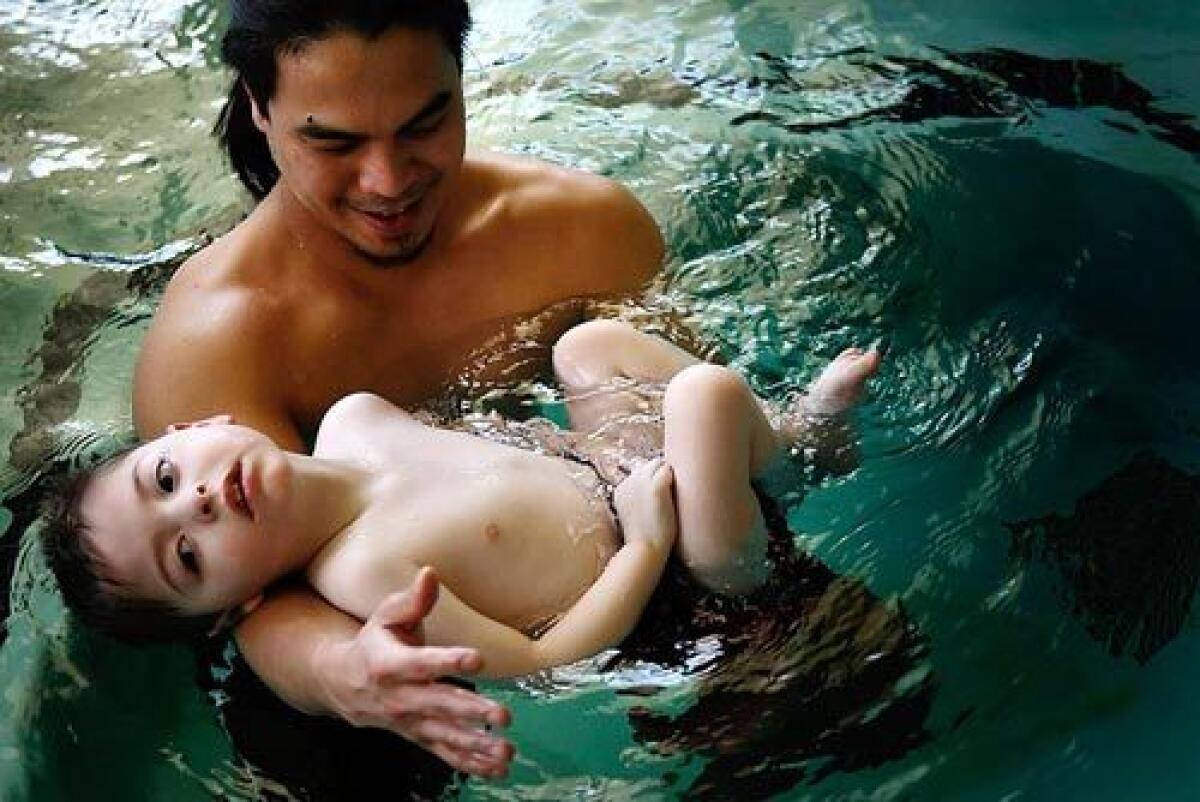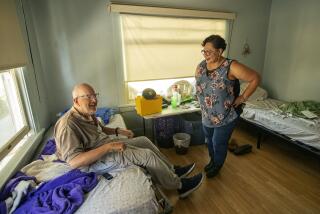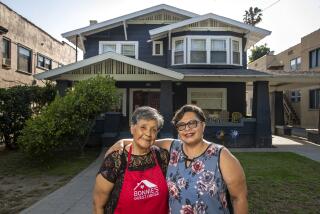Children’s hospice in danger of closing

Reporting from San Leandro, Calif. — At this late date, about the only thing Mary Stark can protect her son from is bad news.
Brandon is dying. He spends much of the day in an old La-Z-Boy recliner that his father rigged on wheels. A NASCAR quilt his mother made is tucked up under his chin. His ventilator hisses quietly.
Stark’s son is in “his favorite place in the world.” Not a hospital, not his bedroom, but by the nurses’ station at George Mark Children’s House, the only free-standing hospice and respite-care center for children in the country.
Brandon has been here since Jan. 15. His status is day-by-day. And so is George Mark’s.
Brandon’s foe is a degenerative disorder called Duchenne muscular dystrophy. The hospice is a victim of the economy; donations have dropped so fast and so far that there is only enough money to operate through June.
Stark has shielded her son from the news, but it eats at her as she sits by his side in the bright Craftsman house on an East Bay hill, loving her boy and waiting for the end.
“That’s my worst fear,” said Stark, 43, “that Brandon’s going to get ready to go and he’s going to get interrupted and have to leave because there’s no money. . . . I couldn’t even imagine. I couldn’t even imagine.”
More is at stake than just the well-being of families. Nearly a dozen facilities, modeled after this hospice, are in the works nationwide. George Mark’s failure would be a blow to their prospects and to a medical discipline, which, at 10 years old in the United States, is still as youthful as many of its patients.
“It would be devastating for the whole newly emerging field of pediatric palliative care,” said Dr. Barbara Sourkes, director of palliative care at Lucille Packard Children’s Hospital at Stanford. “Across the country, George Mark stands for so much. It would send an absolutely terrible message.”
Brandon “is on his own journey plan,” his mother said one recent afternoon, a trip she never anticipated when her oldest son was born 22 years ago.
It wasn’t until he was 5 that Brandon was diagnosed with a form of muscular dystrophy that largely afflicts boys, strips them of their ability to walk and then breathe, and frequently kills them by the time they are college age.
His odd gait -- arched back, chest thrust out -- was the first indication. He had a hard time running and getting up when he fell. He was in a wheelchair by 7, had a tracheotomy at 19. His digestive system began to fail when he was 20. These days, he is too out of breath to talk.
Taking care of a child with what doctors call a “complex, chronic, life-threatening illness” is not impossible, Stark says, but it turns a home into a hospital and a family into an overworked support staff.
“At home, I was his nurse and doctor and social worker,” she said. “Being here, I can be his mom again, just hang out, love him, wipe his face, have patience.”
Brandon started coming to George Mark Children’s House in 2006 to give his exhausted parents an occasional weekend off. He was 19 and still under the care of pediatricians because he suffers from a childhood disease.
Stark describes her son’s condition as a slow downward drift, steep declines followed by long plateaus. Last October, he spent a week in the hospital. At Thanksgiving, he took a bad turn. The family celebrated Christmas early, just in case.
By mid-January, “he looked at me and said he needed to come to the George Mark House,” Stark recounted. “We thought he wouldn’t last a week. He went outside for the first time in six months -- at 10 at night to look at the stars. You learn it’s OK.”
Brandon stays in an Olympics-themed room with hidden hospital equipment. Mary and her husband, Steve, sleep there with him. Zachary, Brandon’s brother, and Sasha, the family dog, stay in one of two family suites.
Steve leaves before sunrise to go to work in San Francisco, where he maintains mechanical systems in high-rises. Zachary, 15, attends high school through an independent study program, goes to karate twice a week and church on Wednesdays.
“In a hospital, you can’t be a family. You can’t bring your family pet,” Stark said. At home, “there’s no way I could afford this 24-hour care, food, laundry. . . . My family would be a mess without this place.”
A stroll through George Mark Children’s House is less about the rooms -- though they are bright and well-appointed -- and more about the children who have filled them.
The 15,000 square-foot facility has eight patient rooms and two family suites. Staff and families dine together in the big, open kitchen called Ruth’s Cafe. There’s a computer room for parents and a playroom filled with books and toys, a pool table and foosball.
The facility, which opened five years ago, is named for two brothers of co-founder Kathy Hull, a clinical psychologist. Mark died at 16 in an automobile accident. George died seven years later of melanoma. The cafe is named for Hull’s mother.
Before George Mark opened, Hull and co-founder Dr. Barbara Beach, a pediatric oncologist, traveled widely in England, which is a pioneer in pediatric palliative care and has nearly 40 children’s hospices.
The hydrotherapy room at George Mark reminds Judith Dunlop, program director and an Episcopal priest, of Manny. His mother died when he was 8, and he moved to Mexico to live with his grandparents. After he was diagnosed with cancer, they brought him to UC San Francisco for treatment. Nine months later, he arrived at George Mark.
“We got him on a good pain regimen,” Dunlop said, “and there were a few days before he died where he was pain-free and just like a 15-year-old boy. He came in here and took the water guns and squirted his grandmother.”
The sanctuary, where families can hold memorial services, reminds Dunlop of Bibiana. Her mother, Janeth, brought her to George Mark for a month to learn how to care for this baby girl with multiple congenital anomalies.
When Bibiana died at 3 months, her stepfather brought a mariachi band into the austere chapel. “It made Janeth very happy,” Dunlop recalled.
Then there’s the George Mark Room, with a cooling blanket on the bed and thermostat turned low. It functions as a kind of old-fashioned parlor, where families stay with their children after they have died and say goodbye.
Unlike even the best hospitals, which must quickly fill rooms with new patients, families here are given the time they need.
“The most gut-wrenching part of the process is not telling the family, ‘I have nothing more to cure your child,’ ” says Beach, George Mark’s medical director. “It’s when that child dies, prying the body out of the parents’ arms.”
After 15-year-old Mitchell Louie died of a glioblastoma in his spine more than a year ago, his family spent three days with his body, receiving visiting relatives and friends. Earlier this month, a 5-year-old lay in state decked out in her princess costume.
“Everything we do here is to try and support the family in anything they want to do, through the worst experience anyone can have,” Dunlop explains. “There’s no making nice about it.”
Hospice is about making people comfortable at the end of life, managing pain, supporting and preparing families for a loved one’s death. The catch is that patients must be in their last six months of life and give up any chance at a cure, such as chemotherapy or radiation.
Most parents of dying children are unwilling to acknowledge the former and will not agree to the latter. This is where George Mark Children’s House comes in.
The facility’s possible demise has reignited a long-standing controversy in pediatric palliative care: Where is the best place to care for a dying child, home or hospital?
Beach and Hull think the answer is often “somewhere in between.” The problem is that, while such care is less expensive than a hospital stay, very little is covered by insurance.
Only about 5% of the care that patients receive at George Mark is reimbursed. The rest of the facility’s operating costs are covered by individual donations and grants. Families are not charged. The average stay is about two weeks for hospice and 10 days for respite.
George Mark relies heavily on year-end philanthropy. But by December, when the economy had hit full swoon, donations were down $1.5 million.
The operating budget has been slashed nearly in half to about $4.4 million. Eight staff members have been laid off. Nine positions have had work hours trimmed. Eighteen people have taken voluntary pay cuts.
Children are referred to George Mark by doctors, social workers or other hospital staff. They must have a progressive disease that has no possible cure and will kill them before they are adults. They must require skilled nursing care, among other criteria.
When there is a waiting list, admission is first-come, first-served. End-of-life patients are given priority. But today, beds are going unfilled because the facility can’t afford more than two nurses each night.
“We are not willing to compromise the quality of care,” Hull said. “But we’re really going to have to examine and prioritize the services we offer. . . . Fewer admissions? Less respite care? We don’t know that yet.” Beach and Dunlop disagree about how important it is for the hospice to remain independent of children’s hospitals in the region; joining forces might help lessen the crisis. Beach thinks the hospice should remain independent. Even many of George Mark’s supporters -- who agree that the kind of care offered here is critical -- think something has to give.
“The business model isn’t sustainable,” said Dr. Jeffrey Goldhagen, chief of community pediatrics at the University of Florida, Jacksonville, which is developing a similar center.
“In the best of times, it works,” said Goldhagen, who called his visit to George Mark “a spiritual experience.” “In the worst of times, it doesn’t.”
Austin Rustrum, 4, is submerged in the warm spa, his little chest encircled by Sheila Pyatt’s big hands, his head resting on her shoulder. A nurse and hydrotherapist, Pyatt has worked to relax Austin’s stiff legs and regain strength in his wobbly neck.
Austin has cerebral palsy, epilepsy and agenesis of the corpus callosum, a rare birth defect in which the structure that connects the brain’s hemispheres is partly or completely missing.
He cannot walk or talk and has difficulty swallowing. He has chronic lung disease, which will likely claim him.
“We just don’t know when,” his mother says, matter of factly. “I don’t want him to die in the hospital or at home.”
Austin comes to George Mark Children’s House for what is called respite care. He needs 24-hour-a-day nursing; his mother gave up her job at a mortgage financing company to care for him.
Packard’s Sourkes thinks respite care is just as important as end-of-life care for families such as Austin’s. She calls them the “silent sufferers” who “cope over decades.”
Families can bring their children here for 28 days of respite care a year at no cost. But this, said Hull, is one area where George Mark might have to cut back until finances improve.
It would be a blow to the Rustrums, who cannot afford this kind of care any other way.
They took out a second mortgage on their Pittsburg, Calif., home and have already exhausted the $165,000. They maxed out their credit cards. They’ve filed for bankruptcy.
Stacey Rustrum and her husband, Geremy, “were on the verge of getting a divorce” when she persuaded him to let Austin come to George Mark for a few days in 2006. It was the first of many visits.
“I devoted all of my time to Austin,” Rustrum said, and Geremy “felt I had no time for him. This place kind of saved us.”
More to Read
Sign up for Essential California
The most important California stories and recommendations in your inbox every morning.
You may occasionally receive promotional content from the Los Angeles Times.











